The Intel Core i9-7980XE and Core i9-7960X CPU Review Part 1: Workstation
by Ian Cutress on September 25, 2017 3:01 AM ESTBenchmarking Performance: CPU Legacy Tests
Our legacy tests represent benchmarks that were once at the height of their time. Some of these are industry standard synthetics, and we have data going back over 10 years. All of the data here has been rerun on Windows 10, and we plan to go back several generations of components to see how performance has evolved.
All of our benchmark results can also be found in our benchmark engine, Bench.
3D Particle Movement v1
3DPM is a self-penned benchmark, taking basic 3D movement algorithms used in Brownian Motion simulations and testing them for speed. High floating point performance, MHz and IPC wins in the single thread version, whereas the multithread version has to handle the threads and loves more cores. This is the original version, written in the style of a typical non-computer science student coding up an algorithm for their theoretical problem, and comes without any non-obvious optimizations not already performed by the compiler, such as false sharing.


CineBench 11.5 and 10
Cinebench is a widely known benchmarking tool for measuring performance relative to MAXON's animation software Cinema 4D. Cinebench has been optimized over a decade and focuses on purely CPU horsepower, meaning if there is a discrepancy in pure throughput characteristics, Cinebench is likely to show that discrepancy. Arguably other software doesn't make use of all the tools available, so the real world relevance might purely be academic, but given our large database of data for Cinebench it seems difficult to ignore a small five minute test. We run the modern version 15 in this test, as well as the older 11.5 and 10 due to our back data.
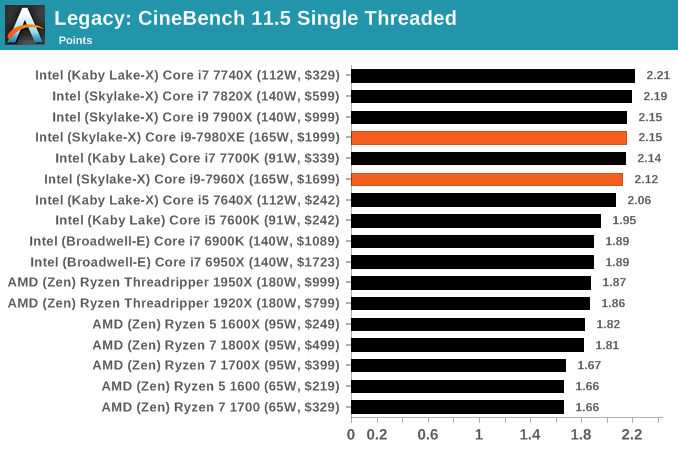
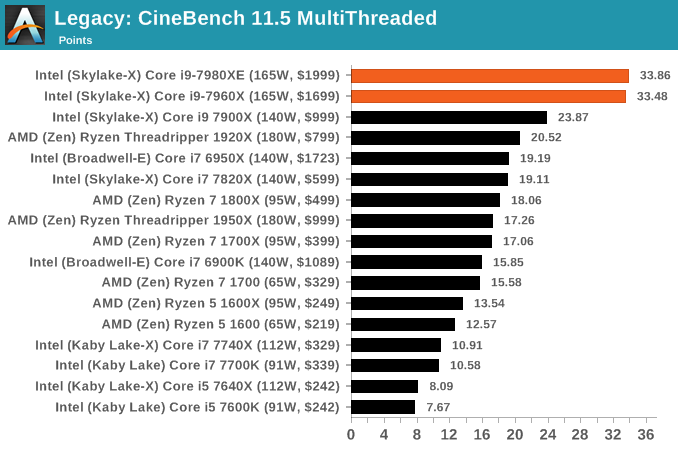
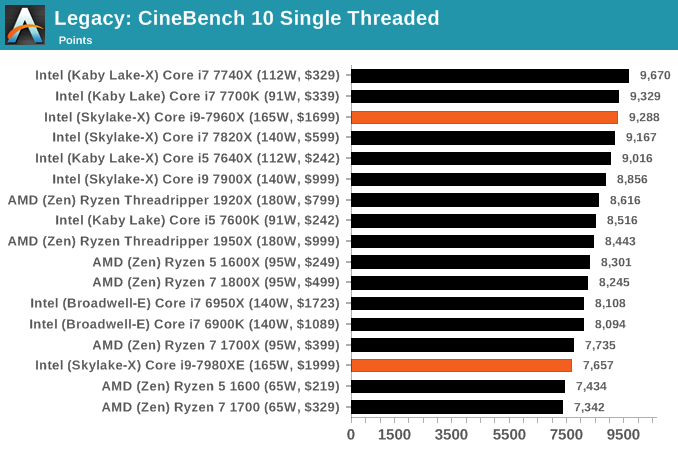
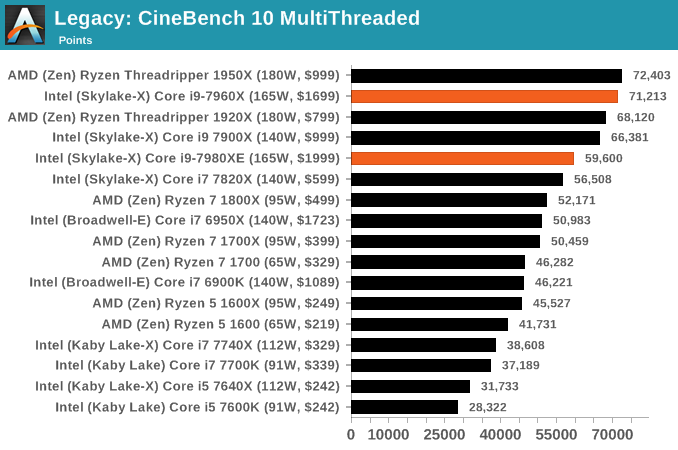
x264 HD 3.0
Similarly, the x264 HD 3.0 package we use here is also kept for historic regressional data. The latest version is 5.0.1, and encodes a 1080p video clip into a high quality x264 file. Version 3.0 only performs the same test on a 720p file, and in most circumstances the software performance hits its limit on high end processors, but still works well for mainstream and low-end. Also, this version only takes a few minutes, whereas the latest can take over 90 minutes to run.
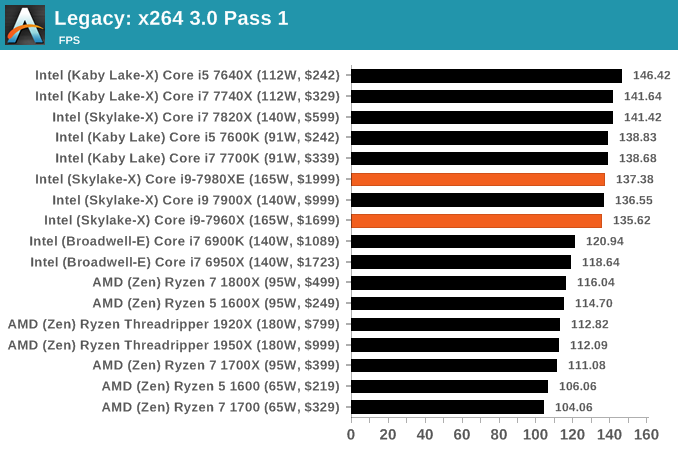
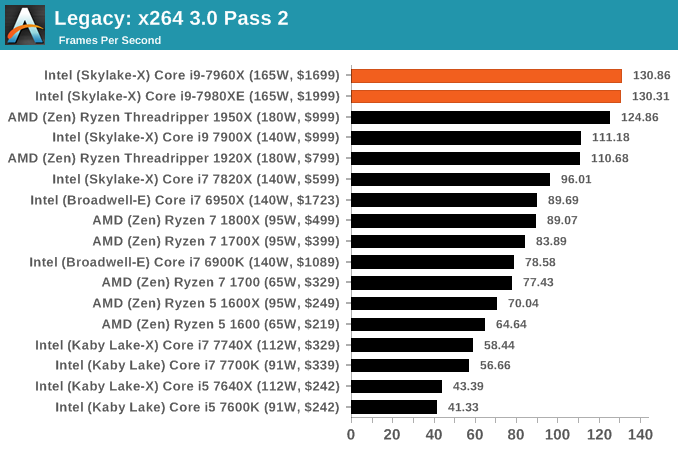










152 Comments
View All Comments
Krysto - Monday, September 25, 2017 - link
Yes, it's total bullshit that they are misinterpreting what TDP is. I imagine this is how they'll get away with claiming a lower TDP than the real one in the 8700k chip, too, which has low base clock speed, but the super-high Turbo-Boost, which probably means the REAL TDP will go through the rough when that Turbo Boost is maximized.This is how Intel will get to claim that its chips are still faster than AMD "at the same TDP" (wink wink, nudge nudge).
Demigod79 - Monday, September 25, 2017 - link
"What a load of ignorance. Intel tdp is *average* power at *base* clocks, uses more power at all core turbo clocks here. Disable turbo if that's too much power for you."I find it ironic that you would call someone ignorant, then reveal your own ignorance about the TDP and turbo clocks.
Spunjji - Monday, September 25, 2017 - link
It is now, it wasn't before. Wanna bet on how many people noticed?SodaAnt - Monday, September 25, 2017 - link
I'm quite curious what happens if your system cooling simply can't handle it. I suspect if you designed a cooling solution which only supported 165W the CPU would simply throttle itself, but I'm curious by how much.ZeDestructor - Monday, September 25, 2017 - link
Strictly speaking, all forms of Turbo boost are a form of vendor-sanctioned overclocking. The fact that measured power goes beyond TDP when at max all-core turbo should really not be all that surprising. The ~36% increase in power for ~31% increase in clocks is pretty reasonable and inline when you keep that in mind. Especially when you factor that there has to have been a bit of extra voltage added for stability reasons (power scales linearly with clocks and current, and quadratically to exponentially with voltage).Demigod79 - Monday, September 25, 2017 - link
I agree. Everything looked good until that page. 190 watts is unacceptable, and Intel needs to correct this right away - either make the CPU run within the TDP limit, or update the TDP to 190 watts in the specs.HStewart - Monday, September 25, 2017 - link
It funny that people complain about CPU watts but never about external GPU watts. Keep in mind the GPU is smaller amount of area.artk2219 - Monday, September 25, 2017 - link
They most certainly do, that is one of the biggest gripes against Vega 64, people do seem to have short memory on how high GPU TDP's used to be however.IGTrading - Tuesday, September 26, 2017 - link
On a video card, the same manufacturer takes responsibility for the GPU, cooling system, design, PCB, components and warranty.On the CPU, you have somebody else designing the cooling system, the motherboard, the power lines and they all have to offer warranty for their components while Intel is only concerned with the CPU.
If the CPU is throttling or burnt out, they will say "sufficient cooling was not provided" and so on ...
It is a whole lot different.
whatevs - Tuesday, September 26, 2017 - link
Thermal throttling is not a burn out and not a warranty event, you don't get to warranty your gpu when it throttles under load, cooling warranty does not include cpu/gpu chip performance andIntel designed the ATX specification and the electrical specification for the boards.
You clearly don't know the things you're talking about.